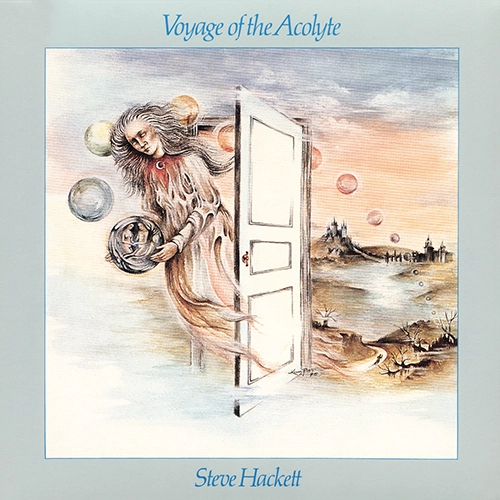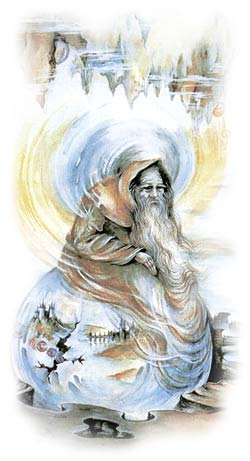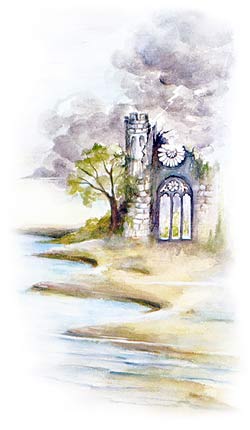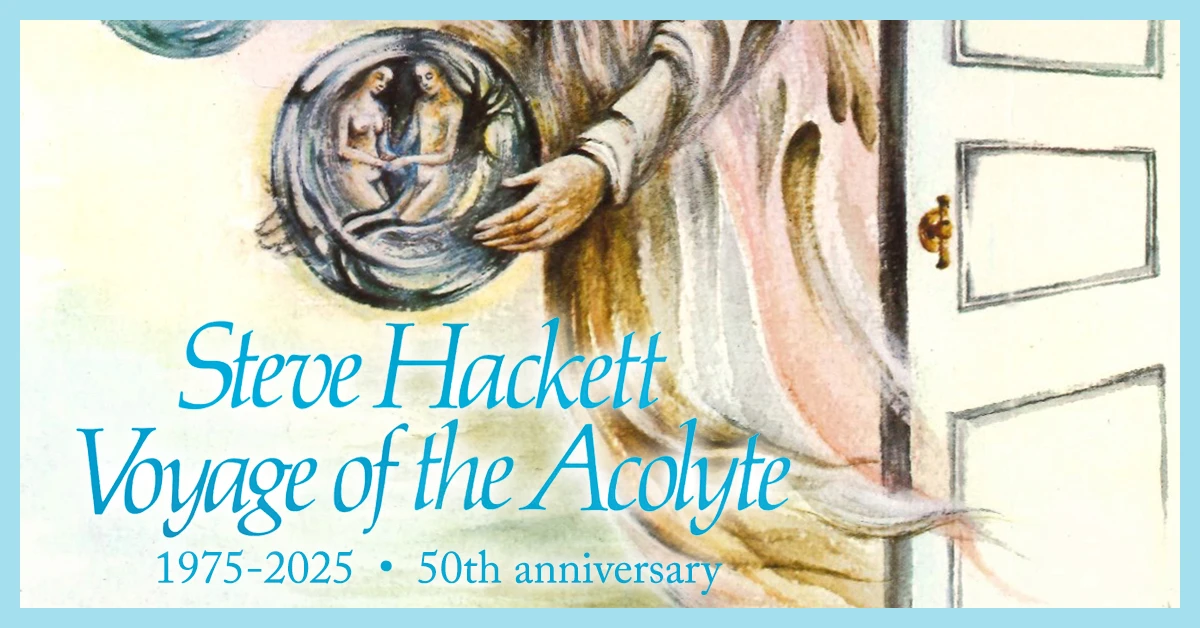- Article
- Read in 10 minutes
Steve Hackett – Voyage Of The Acolyte – review
In 1975 Steve Hackett, lead guitarist with Genesis, became the first member of Genesis to release a solo album.
In 1975 Steve Hackett, lead guitarist with Genesis, released his first solo album. It marks the extraordinary beginning of an ongoing career, and many fans consider it his finest album ever.
The background:
The idea that Steve Hackett releases a solo album may have shocked many fans. Genesis had just lost their singer and supposed musical mastermind Peter Gabriel, the future of the band seemed uncertain. Was Hackett’s debut another indication that the band was breaking up? He was the first one to release a solo album, and that, too, surprised people, because during Genesis live performance he had always been the most unobtrusive of the lot, sitting still and unmoveable at the side of the stage.
Listening to the album dispelled most of the worries and speculation. The music was very compact and very sophisticated from the first to the last note. A certain ‘Genesis sound’ is evident on the album not only because his band mates Collins (drums, percussion, vocals) and Rutherford (bass, bass pedals, fuzz 12-string) played on it. Hackett’s guitar has moved to the front, though, and the keyboard mostly accompany him.

Hackett could let it all out and show he is a master of the strings, but he does not really. There are many moments, to be sure, where he demonstrates the breadth of his repertoire from classical acoustic to fast and rocky, but all these part remain in the context of the album and the piece in question. Hackett is no show-off, he is a musician and a composer who knows when to show and when to conceal.
Steve’s band mates and his brother John support him, whose extraordinarily melodic flute-playing adorns Hackett’s works to this day. Keyboarder John Acock, cello player Nigel Warren-Green and Robin Miller (oboe and the related coranglais) help give this song a sound different from Genesis. Only three songs have vocals. Hackett himself sings on the one, Phil Collins joins him on the second piece while Sally Oldfield provides her clear voice on the third. While opinions may differ about Hackett’s singing and Oldfield’s vocals are flawless, the drummer’s vocal performance is surprisingly good.
Up to this album Collins only did backing vocals in Genesis, singing lead vocals only on the ballads More Fool Me and For Absent Friends which did not win him all the fans’s sympathies. His performance here is solid and shows that he is not only a good drummer but also a fine singer. Those who heard Voyage Of The Acolyte in 1975 will not have had any doubts about Collins’s qualifications as the lead singer when it turned out that Genesis would continue with Collins as the front man.
The concept: Of One Who Went To Find Wisdom In Love
The delicate, mysterious cover designed by Kim Poor prepares the listener for equally tender music. The titles of both the album and the songs betray an unexpected New Age influence as they are linked to tarot cards. Hackett goes beyond crystal ball stories told by elderly ladies with a migration background in dark tents. His music and the cards tell the story of a journey towards finding oneself. The cards are both trigger and background for a bildungsroman in which they mark single steps.
The main character in this story is the travelling acolyte, a young, wanton naive man who sets out into the worlds full of high spirits. The beginning of his journey is marked as the Ace Of Wands card. Equalling clubs in a set of playing cards, wands are related to the element of fire in tarot. The ace signifies the purest essence of this aspect – the pure energy with which the traveller embarks on his adventure of finding higher truths and revelations.
His first stop is the High Priestess (Hands Of The Priestess I). This card is frequently equated with the Egyptian goddess Isis, who is mentioned again later. Behind her veil she hides many secrets. The traveller tries to spy them out, to lift the veil, but apparently he is not mature enough yet. He is just a naive hotspur. The secret will have to wait.
He is disappointed, frustrated, angry. This mood leads to a series of unspecified mistakes that lead to a catastrophe. In tarot there are some cards that have a mainly negative connotation. The card of Death, as is now generally known, does not indicate a fatal end but simply change. At this point, however, the traveller comes upon the tower, one of the most destructive and negative cards in the tarot deck. The tower can mark a new beginning, too, but only after a complete breakdown of the old. The card usually shows A Tower Struck Down by lightning. This is not a change, but a revolution. The traveller’s world collapses, and he stands in the ruins of the old from which something new can grow.
He loses his naivety in this first painful experience and gains a certain maturity – enough to reach a higher level of understanding and clearness. The veil of Isis lifts and reveals the secret of the High Priestess (Hands Of The Priestess II). Even though he is now equipped with new knowledge the traveller has not come any nearer to wisdom. He has to digest his lessons before it turns into wisdom. He withdraws to process what he has learned in silent contemplation (The Hermit). At the end of his spell of solitude lies insight.
A new star appears in the skies (Star Of Sirius) and points the way for the traveller out of his solitude and into the light. The knowledge of Isis has reestablished the order that was lost after the collapse of the tower. The path lies clear before the traveller, and he is led by a star. The revelation seems to be that all wisdom grows out of love. Infinite worlds open up to those who know how to love.
And so the traveller indulges in love (The Lovers). We are not told who he has found, but he finally finds wisdom. In the end we see him as the wise man, the high priest – but only blurred, only his shadow (Shadow Of The Hierophant). His journey is over … or is it?
Piece by piece:

1. Ace Of Wands
The Ace of Wands embodies the pure essence of fire, pure energy. The album begins accordingly strong and anything but esoteric and mellow. Rhythms are jumpy and playful, a frenetic dance around the fire before the flames suddenly seem to die down and leave space for acoustic sounds. Hackett’s brother John gives the illusion of a small flickering flame with his flute. Hackett also shows with who he has spent the years before – with band colleagues Rutherford on bass and Collins on drums this piece is based on a masterly rhythm group.
He leaves lots of room for his fellow musicians. The guitar is the leading instrument but he has no problem to stand back when the keyboards or the flute fit better. Hackett relies on his skills as a composer and does not neglect the music for his ego.
Ace Of Wands is a strong opener that, except for brief quiet parts, constantly changes directions, flits to and fro and stirs up the listener. Despite all that is never seems forced but relaxed and merry. One can almost feel the traveller’s thirst for action as he embarks on his journey.
2. Hands Of The Priestess I
The second number puts a damper on the euphoria. Just like the secrets of the high priest that have not been revealed yet this piece seems a veil dance. Hackett’s gentle electric guitar and his brother’s flute swap the melody, seemingly circling each other. They are accompanied by soft violin strings and twelve-string guitar. The melodies are beautiful and calm, a pleasant rest after the introductory tour de force. When the music fades it does not feel that you have reached your goal, though. You circle it slowly, carefully, but the secrets you came looking for have not yet been revealed.
3. A Tower Struck Down
Instead you are hit by what seems like a catastrophe. The next piece adds another bit to Hackett’s range. A Tower Struck Down is harsh, loud, seems monotonous and takes your breath away. The beat seems beyond recognition until the system of 3/8, 3/8, 2/8 reveals itself, the third bar always feeling too brief, too cut-off, without any time to breathe. The piece seems gloomy, fatalistic as the tarot card it is linked to, moves on into a second equally complex and monotonous motive that loses itself in a loop of “Sieg Heil!” shouts until everything collapses around the listener. Despite all the New Age things Hackett suddenly introduces contemporary references to make his intention clear.
What follows from the fascist catastrophe, this biggest sin of human civilisation that introduces total doom for him? A couple of quiet mellotron sounds, some subdued guitar strums. A bleak desert – hard to believe that anything could grow from it again. And yet…
4. Hands Of The Priestess II
… acoustic relaxation fades in again. But right from the start Steve adds a new melody to the familiar sound. The crystal sounds of an oboe rise like a revelation from the debris of the tower. The veil of Isis lifts. Relief mixes in with the elease of tension. After that first part the melodies provide an unexpected and unusual highlight of the album. Though gentle the music seems playful and light like the strong opening. Its contrast to the previous piece could hardly be stronger, and the listener realizes how well Hackett can handle various musical styles and combine them into a coherent whole.
5. The Hermit
There is a new dimension to the album: vocals. Hackett himself sings the terse verses in a deep, restrained voice accompanied by 12-string guitar that is finally complemented by a cello, John Hackett’s flute and an oboe. The wind instruments are some depth to this tender piece and the catchy vocals. Hackett, it appears, lacks confidence in his voice. In later years he will frequently sing most of his songs himself, but add lots of effects to his voice. In this case it is a strong echo that alludes to the cave the hermit may be living in. The song ends as gentle as it began, without major surprises.
6. Star Of Sirius
The album remains calm for the time being, though the sounds become clearer and arrangements denser. Hackett also sings on this song but the central voice is that of Phil Collins, who had previously mainly sung backing vocals in Genesis. The acoustic guitar is accompanied by mellotron, oboe and vibraphone. The vocals are much more distinguished than before, the melody becomes more interesting and for the first time Collins’s singing can be fully appreciated. The star does not only point the way for the former hermit, it leads the whole album in another direction as the chorus is suddenly upon the listener like a straightforward song. Everything seems clearer, faster and more direct. This underlines what the traveller has learned, his new direct way towards things. Note how the album hovers between solemn melodies and light, playful elements supporting the content. The new departure is indeed a lightfooted one.
7. The Lovers
A brief, quiet acoustic piece marks the end of the journey. The traveller has arrived, found his love that makes him complete. The piece is so short that is hardly sticks in one memory, but it provides the necessary space between the surrounding pieces. It gives, as it were, only a brief glimpse at the protagonist’s private (love) life before it withdraws discreetly.
8. Shadow Of The Hierophant

Hackett goes out with a big finale. Once more he pulls out all the stops. The piece begins with an almost bombastic melody. Solemn electric guitar accompanied by big mellotron string sounds and a simple drum sound that is closer to Nick Mason’s work in Pink Floyd than to the playful technique Collins had back then. The curtains open once more and the lights give all.
Suddenly, silence. A simple concert guitar and Sally Oldfield’s crystal clear voice; her extreme soprano almost hovering on the painful. A light, dancing flute decorates all this from far in the background. Both motives alternate several times before a bridge of brief e-guitar notes moves the piece on into a guitar-led melody Genesis could not have arranged any better.
Glockenspiel brings in the last motive that seems to turn into a loop. Slowly, oh so slowly the same melody fades in on the guitar. The guitar sounds very soft but somehow compressed. While the melody grows louder the arrangement becomes more compact. The drums are played very strongly. Strings mix with a choir until tubular bells underline the big moment and the melody fades almost as slowly as it was introduced. It feels as if the listener, like the music itself, was turning around and around and around. Even after the last note has died away one has the impression that it will go on like this forever.
The outcome is glorious, majestic and strong, bordering on aggressive. Who, then – to return to the interpretation we have attempted above – is this figure at the end of this way? Has the traveller’s journey really ended or does his arrival just bring up new problems, new questions so that it all goes around and around in circles forever?
All in all…:
Steve Hackett’s Voyage Of The Acolyte is the beginning of a great solo career, during which Hackett has never tired of producing high-quality music. Just like his traveller he has embarked on a journey that has begun with this powerful, multi-faceted album that begins strongly, ends great and alternately surprises and gives space to breathe in between. Just like his protagonist Hackett seems not to have reached the end of his quest. And that is a good thing.
by Hendrik Lang
translated by Martin Klinkhardt
50 years Voyage Of The Acolyte! Discuss this album with other fans in our forum in this thread and pick your favorite tracks in our poll!

